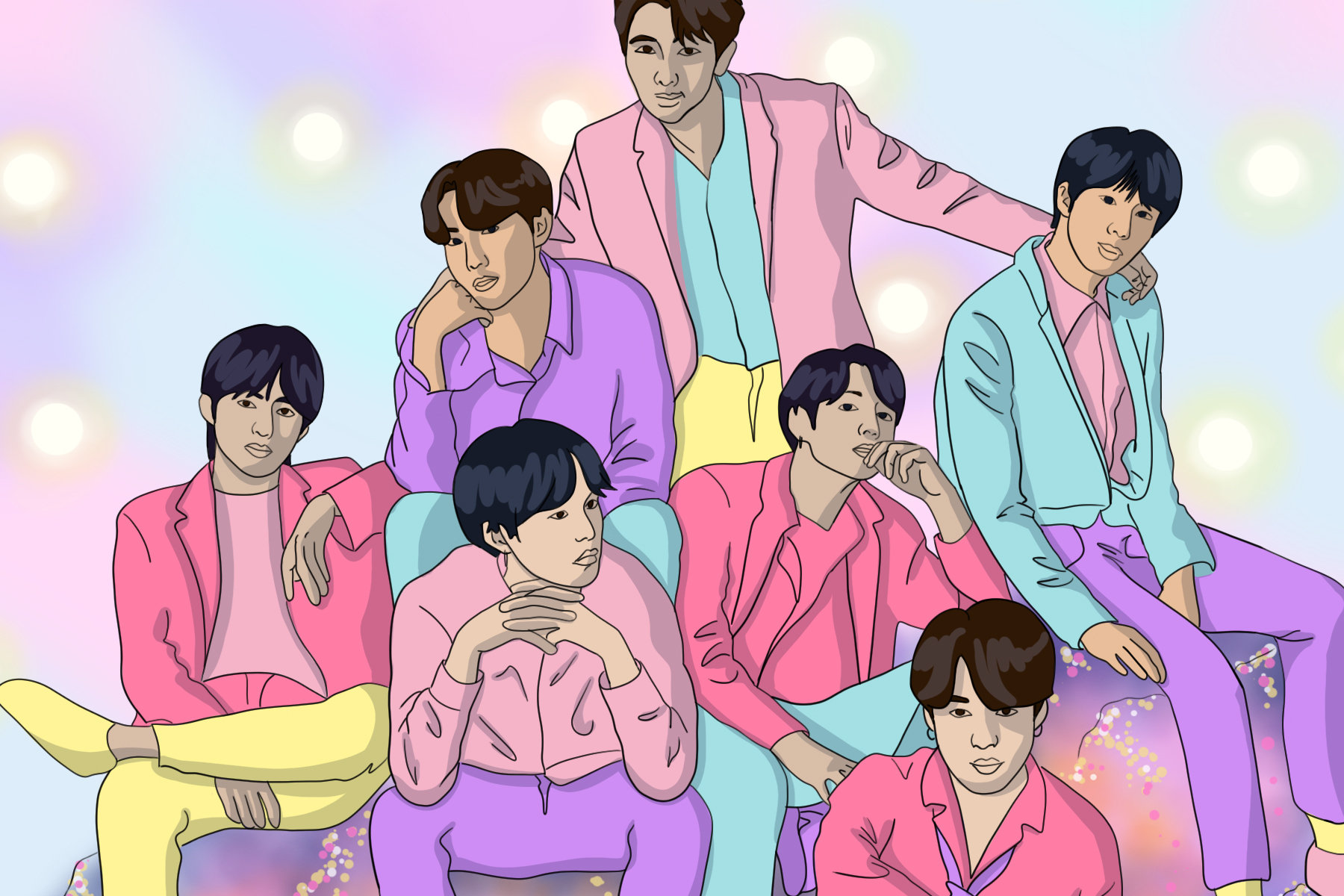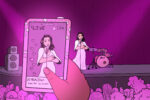BTS just received their first Grammy nomination for best pop duo/group performance last Sunday, which is not only a huge first for them, but it’s also the first Grammy nomination for a K-pop act. The group has led the spread of the K-pop genre to the massive global influence it enjoys today, but more importantly, has led the spread of important messages of self-love, gender positivity and the ability of the individual to change the world.
Still, despite BTS’s global popularity, there’s still an overwhelming stereotype that these male idols are “girly” because of their appearance. Comments along the lines of “Oh, but they look like girls. Why do you like them?” plague fans and supporters of BTS. There’s even a boot camp in China that trains Chinese boys to be “real men” to fight the BTS idol effect, as Chinese parents are anxious about their boys becoming “sissy pants” men who wear makeup and earrings. It’s precisely this damaging expectation that BTS hopes to change so that everyone will be respected for their own worth, regardless of appearances or preferences for dress that may be less conventional.
In a speech to the United Nations in 2018, BTS’s leader, Kim Nam-joon, better known as RM, expressed, “No matter who you are, where you are from, your skin color, your gender identity, just speak yourself.”
BTS has redefined what it means to be masculine and attractive in a culture where toxic expectations of masculinity and gender norms put the health and well-being of boys and men at risk, as well as contributes to the perpetuation of violence — and makes them the subject of violence themselves.
As conceptualized by The New York Times, toxic masculinity is associated with “suppressing emotions or masking distress,” “maintaining an appearance of hardness” and using “violence as an indicator of power.” When a man doesn’t possess these characteristics, he’s often seen as “feminine” or weak, especially in Western cultures.
From their clothing and choice of expressions to their music and performance concepts, BTS is a leader in demonstrating how to be unafraid of expressing gender identity, regardless of traditionally held ideas of “femininity” or “masculinity.” It’s a much-needed message for those who struggle with fears of retribution or criticism, as it shows that this form of expression can be both accepted and celebrated.
BTS has redefined masculinity in many ways and the most obvious is how they present themselves physically.
They regularly wear women’s clothing in their performances, photoshoots and award ceremonies, along with accessories that are often considered “feminine,” such as corsets, chokers and necklaces, dangly earrings, bracelets and decorative rings. It’s a subtle but prominent message in their fashion choices: You should have the freedom and fluidity to wear whatever you want, regardless of gender.
여성복 입는 지민이가 너무 좋아서 모아봤어요 pic.twitter.com/VocvVqFh4e
— slow 뮤니 (@_Oo_13) August 19, 2019
In 2016, BTS did a legendary photoshoot for Singles Magazine where they wore fishnets, lace, corsets and skirts.
https://twitter.com/hianmo/status/1337846146937606145?s=20
They also wear makeup regularly, both heavy, glamourized looks for performances and light “natural” looks for daily outings and for interviews and the press. In fact, they make it a point to wear makeup, with some of their interviews and behind-the-scenes videos pointing out a particularly well-done eyeshadow or speaking on their preference for a certain makeup look.
They are also the official representative and model for VT cosmetics, as well as for Mediheal, a popular skincare brand in Korea.
https://twitter.com/mollajoon/status/1269981163441004544?s=20
Moreover, in a “Run BTS” episode, one of the members, Jimin mentions giving his father a makeover.
jimin really said that he wants to do his dad's make-up and he HAS BEEN thinking about it hshsahs 😭😭 pic.twitter.com/Yl0TPizquR
— 𝘫 𝘮 𝘵 (@jiminticaI) July 18, 2019
From using gender-neutral language to breaking barriers within Korean culture, the way that BTS expresses gender in their music and art is multifaceted. BTS showcases that loving yourself should go beyond the physical, as owning your identity is also owning the various forms of your personal self-expression.
BTS’s performance at the 2018 Melon Music Awards featured Jimin performing Buchaechum, a traditional Korean fan dance, which is traditionally performed by groups of Korean female dancers.
Their songs are also gender-neutral. They use “her,” “she,” “he,” “him,” “they” and “them” as interchangeable pronouns, and switch tenses often, which contributes to a sense of fluid meaning. In the canon of BTS musical concepts, all forms of love and its many dualities are explored. They sing, rap and speak of love openly in ways that go beyond traditional, monogamous or sexual ideas of romance. They suggest that love for yourself and others goes so much further than physical attraction — a refreshing take on pop and rap music that doesn’t hype lasciviousness or revolve around perceiving people as objects of conquest.
They have no qualms about rejecting social constructs that assert that men should not cry, share their feelings or show emotions. The members of BTS openly show their emotions in their appreciation for their fans and in their success, crying on stage and in award ceremonies. Both RM and Suga have openly spoken about their struggles with anxiety and depression as trainees and now as global phenomena, saying that it’s always been music that ends up being their savior. There are countless videos on YouTube and V Live (a South Korean streaming app) where the group sits together and talks about their hopes, dreams and anxieties.
In an interview with Esquire, BTS member Suga (Min Yoon-gi) expressed, “There is this culture where masculinity is defined by certain emotions and characteristics. I’m not fond of these expressions.”
As Suga references, masculinity is often defined by machismo or the “macho man,” characteristics of toughness, ego and ambition, and an expectation to not show emotions or allow yourself to feel or cry. It defines a real man as someone who is tough, controlled, dominant, “rational,” sex-obsessed and entitled to respect. Masculinity is also framed as the opposite of anything deemed feminine or queer — and being cast as queer or feminine is considered insulting to those who have internalized this view of masculinity.
These gender norms, especially those related to rigid notions of masculinity, are detrimental to one’s well-being. For example, specific notions of masculinity may encourage boys and men to smoke, take sexual and other health risks, misuse alcohol and not seek help, especially when it comes to mental health. Such gender norms also contribute to boys and men perpetrating violence, as well as being subjected to violence themselves, creating a toxic, self-perpetuating cycle of cruelty.
On the other hand, the expectation of women and girls to be “feminine” and caregivers first also creates discrimination and gender inequality that can be detrimental to their prosperity. Women and girls often face greater barriers than men and boys to accessing information and services. These barriers include restrictions on mobility, lack of access to decision-making power and lower literacy and educational rates.
Rigid gender norms also negatively affect people with diverse gender identities, who often face a higher risk of mental disorders, HIV and suicide as a result of the violence, stigma and discrimination perpetuated because of their identities.
But many forget or are unaware that the premise of the idea of “masculinity” is constructed by society itself, through standards of beauty that are fluid by nature. Gender, like any social construct, is fluid and subject to changing definitions and expectations. The World Health Organization defines gender as “refer[ing] to the characteristics of women, men, girls and boys that are socially constructed. This includes norms, behaviours and roles associated with being a woman, man, girl or boy, as well as relationships with each other. As a social construct, gender varies from society to society and can change over time.”
In that sense, how can you define (or persecute) someone for not falling within such vague, vagarious standards of “feminine” or “masculine”?
While gender may be a social, psychological and cultural construct, our reason for polarizing gender is influenced by sex — that is, the biological dichotomy of male and female. A study conducted by Faceresearch.org in 2010 across 30 countries found that women’s preferences for men’s masculine facial features are grounded in ecological and environmental conditions.
“Manlier” faces (heavy brows, a strong jawline, broad face) were attractive in poor ecological conditions — that is, where the infant mortality rate is high and women would want to “maximize” their chance of offspring. In a country with healthier populations (and low birthrates), women actually prefer more “feminine” looking men (those with the weakest “macho” appearances), as they were thought to be more loyal, compassionate and better caregivers — all characteristics necessary for an environment where a household might have only one or two children for the duration of their lifespans. The study showed that traditional “macho” men were assumed to be “cheaters” and bad caregivers.
But gender can also include cultural constructs unrelated to sex.
Cultural influences on gender begin at birth with the gendered naming and clothing of the child and continue throughout life. Gender-specific names and attire enhance the internalization of expectations for gender-specific behavior. Parents, through subtle interactions like buying only dolls for girls or flatly telling boys that they need to “man up” and not cry, encourage and discourage certain behaviors that lead to a child’s development of their gender identity.
When a boy decides he wants to play dress-up in skirts or makeup or a daughter chooses to play aggressive sports with boys, it would not be surprising to find the parents redirecting the child’s behavior into a more socially “acceptable” and gender-specific activity. Research has shown that children, starting from the age of two, classify people into gender categories based on their appearance.
And according to a survey conducted by the Pew Research Center, the way a man views his own masculinity is related to his ideas about raising children. Among men who describe themselves as very manly or masculine, 40% say it’s a good thing for parents to encourage boys to play with toys or take part in activities that are normally associated with girls while 58% of these men say this is a bad thing.
Furthermore, on the idea of “gendered” attire, the expectation that only one gender can wear certain styles is ludicrous, especially when you consider that high heels, skirts, stockings, makeup and hair extensions were all worn by both women and men equally throughout history.
Since the beginning of civilization, skirts have been the go-to garment for most of humanity, on both sides of the gender divide. Gauzy linen and sturdy loincloths for Egyptians; togas that denoted class and status for Greeks and Romans; exquisite silk robes in Ancient China; elaborate military costumes for Aztecs, the tunic or short skirt in medieval Europe — ancient attire has always been based around the idea of the skirt or the dress, as they were easy to construct and enabled freedom of movement. Whether you were farming, building, fighting, debating, praying or ruling, skirts were efficient and cheap and also provided ample means of ornamentation and costuming. Even throughout the 19th century, skirted garments were still acceptable in many contexts in European and Asian society.
Minoan artifacts, dating from 2900 to 1150 B.C., illustrate both male and female youths with extremely tiny waists, suggesting that boys and girls around the age of 12 or 14 wore belts that constricted the waist, better known to us today as corsets. And there have been multiple periods throughout history when men adopted the corset to achieve the fashionable silhouette of the time — just look at any historical painting for evidence of their slim waists. The 1830s specifically brought back male girdles that created feminine wide hips and nipped waists.
Men wore jewelry off and on, and in the mid-16th century, they often wore a single dangling earring along with their wide, padded breeches that resembled puffy skirts. High heels too, were originally invented and worn by men. King Louis XIV was aesthetically extravagant in many regards, and as he was only 5 feet and 4 inches tall, he undoubtedly required the assistance of his shoes (some of which were 6 inches high) to maintain an imposing authority. As modern women know, heels also help produce flexed, shapely calves, which were still very much in the style of the Sun King’s time.
And who can forget the wigs? Even today, barristers in UK courts don robes and powdered wigs as a hallmark of the time when wigs were very much en vogue, and as a testament to the formality and solemnity of the court.
BTS themselves, as a global purveyor of gender-positive messaging, switches seamlessly between what is considered feminine and what is considered masculine in a way that is novel and liberating in our current society. Though it’s hard to tell if BTS will have a lasting effect on masculinity as a rigidly defined concept, it’s safe to say that simply by offering a new take on what it means to be masculine and attractive, BTS is paving the way to a new era of greater social acceptance of gender outside the “norm.”

















